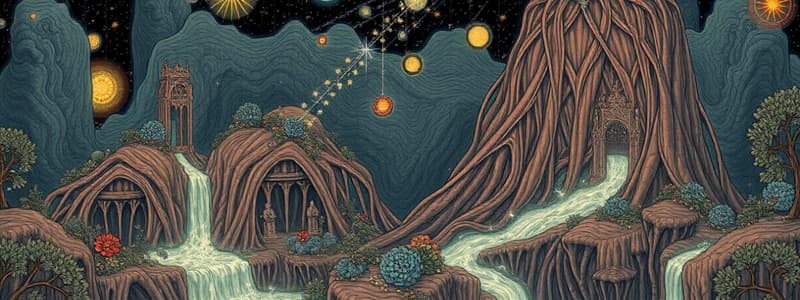Podcast
Questions and Answers
Which of the following is NOT an endogenic process?
Which of the following is NOT an endogenic process?
- Inner core
- Erosion (correct)
- Metamorphism
- Tectonic movements of the crust
Which of the following processes in the asthenosphere is responsible for the formation of magma?
Which of the following processes in the asthenosphere is responsible for the formation of magma?
- Decreasing pressure
- Addition of water
- Increasing temperature (correct)
- Removal of gases
Which of the following is formed from the accumulation of low-viscosity lava that reaches the surface through fissures?
Which of the following is formed from the accumulation of low-viscosity lava that reaches the surface through fissures?
- Caldera
- Lava plateaus (correct)
- Hot springs
- Geysirs
Which of the following is the general term used to describe rocks made from the cooling and solidifying of molten rock?
Which of the following is the general term used to describe rocks made from the cooling and solidifying of molten rock?
What is the other name for intrusive igneous rock?
What is the other name for intrusive igneous rock?
Which of the following rocks are formed when lava cools and solidifies on the earth’s surface?
Which of the following rocks are formed when lava cools and solidifies on the earth’s surface?
Where would you expect to find the largest crystals in a lava flow?
Where would you expect to find the largest crystals in a lava flow?
What type of volcanic rock contains a large number of cavities (bubbles) that form when gases escape from the molten rock?
What type of volcanic rock contains a large number of cavities (bubbles) that form when gases escape from the molten rock?
What is a key focus of the module on endogenic processes of the Earth?
What is a key focus of the module on endogenic processes of the Earth?
Which of the following is NOT listed as a Most Essential Learning Competency (MELC) for this module?
Which of the following is NOT listed as a Most Essential Learning Competency (MELC) for this module?
What does magmatism refer to in the context of the module?
What does magmatism refer to in the context of the module?
What method is suggested for predicting the future behavior of tectonic plates?
What method is suggested for predicting the future behavior of tectonic plates?
What are the expected outcomes regarding metamorphism in the module?
What are the expected outcomes regarding metamorphism in the module?
Which statement best describes the processes of folding and faulting?
Which statement best describes the processes of folding and faulting?
Why is the Earth's interior hot?
Why is the Earth's interior hot?
What natural phenomenon is a consequence of volcanic activity?
What natural phenomenon is a consequence of volcanic activity?
What is the primary function of geothermal wells?
What is the primary function of geothermal wells?
At what approximate depth does hot water reach a temperature of 300 °C in geothermal fields?
At what approximate depth does hot water reach a temperature of 300 °C in geothermal fields?
How is a cinder cone volcano primarily formed?
How is a cinder cone volcano primarily formed?
What characterizes the top of a cinder cone volcano?
What characterizes the top of a cinder cone volcano?
What is volcanism?
What is volcanism?
What happens to thermal water in subterranean geothermal systems?
What happens to thermal water in subterranean geothermal systems?
What is a caldera?
What is a caldera?
What material is primarily ejected from a cinder cone volcano?
What material is primarily ejected from a cinder cone volcano?
What is the primary material being extruded by Mount Mayon?
What is the primary material being extruded by Mount Mayon?
Which term refers to the process of rock formation change due to internal heat and pressure?
Which term refers to the process of rock formation change due to internal heat and pressure?
What does the Greek word 'meta' mean in relation to geology?
What does the Greek word 'meta' mean in relation to geology?
Which of the following rocks is an example of a metamorphic rock?
Which of the following rocks is an example of a metamorphic rock?
What is the main factor affecting contact metamorphism?
What is the main factor affecting contact metamorphism?
Which phenomenon describes the eruption of materials from Earth's interior to its surface?
Which phenomenon describes the eruption of materials from Earth's interior to its surface?
Which of the following is a characteristic of phyllite?
Which of the following is a characteristic of phyllite?
What is the defining characteristic of metamorphic rocks?
What is the defining characteristic of metamorphic rocks?
What is the process by which magma rises through the crust and crystallizes as an intrusive igneous rock beneath the Earth’s surface?
What is the process by which magma rises through the crust and crystallizes as an intrusive igneous rock beneath the Earth’s surface?
What term describes the changes in mineral assemblage and texture due to rock being subjected to altered conditions?
What term describes the changes in mineral assemblage and texture due to rock being subjected to altered conditions?
What type of metamorphism occurs adjacent to igneous intrusions due to high temperatures?
What type of metamorphism occurs adjacent to igneous intrusions due to high temperatures?
Which type of metamorphism affects large areas and generally does not relate to igneous bodies?
Which type of metamorphism affects large areas and generally does not relate to igneous bodies?
What is the term for the hot, molten rock located beneath the Earth's surface?
What is the term for the hot, molten rock located beneath the Earth's surface?
What is the term used for molten rocks that are ejected onto the Earth's surface during a volcanic eruption?
What is the term used for molten rocks that are ejected onto the Earth's surface during a volcanic eruption?
From which of the following does an explosive volcanic eruption primarily originate?
From which of the following does an explosive volcanic eruption primarily originate?
Which of the following processes describes the transformation of solid rock into magma?
Which of the following processes describes the transformation of solid rock into magma?
Where does decompression melting take place?
Where does decompression melting take place?
Which of the following is NOT a factor of partial melting?
Which of the following is NOT a factor of partial melting?
What process is described when the melting points of minerals decrease due to the addition of water or carbon dioxide?
What process is described when the melting points of minerals decrease due to the addition of water or carbon dioxide?
Which minerals are likely to melt last during partial melting?
Which minerals are likely to melt last during partial melting?
What are the two most abundant elements found in magma?
What are the two most abundant elements found in magma?
What is the expected change in temperature of rocks during partial melting?
What is the expected change in temperature of rocks during partial melting?
What is NOT associated with the process of metamorphism?
What is NOT associated with the process of metamorphism?
What is the primary factor influencing regional metamorphism?
What is the primary factor influencing regional metamorphism?
Flashcards
Endogenic Processes
Endogenic Processes
Processes that occur within the Earth's interior, affecting its structure and surface.
Earthquakes
Earthquakes
Sudden shaking of the Earth's surface caused by the movement of tectonic plates.
Volcanoes
Volcanoes
Openings in the Earth's surface through which molten rock (magma) erupts.
Tsunamis
Tsunamis
Signup and view all the flashcards
Magmatism
Magmatism
Signup and view all the flashcards
Metamorphism
Metamorphism
Signup and view all the flashcards
Geologic Processes
Geologic Processes
Signup and view all the flashcards
Earth's Interior Heat
Earth's Interior Heat
Signup and view all the flashcards
Magma Formation in Asthenosphere
Magma Formation in Asthenosphere
Signup and view all the flashcards
Lava Plateau
Lava Plateau
Signup and view all the flashcards
Igneous Rock
Igneous Rock
Signup and view all the flashcards
Intrusive Igneous Rock
Intrusive Igneous Rock
Signup and view all the flashcards
Extrusive Igneous Rock
Extrusive Igneous Rock
Signup and view all the flashcards
Volcanic Rock (Crystals)
Volcanic Rock (Crystals)
Signup and view all the flashcards
Vesicular Volcanic Rock
Vesicular Volcanic Rock
Signup and view all the flashcards
Geothermal Energy
Geothermal Energy
Signup and view all the flashcards
Hot Springs/Geysers
Hot Springs/Geysers
Signup and view all the flashcards
Geothermal Field
Geothermal Field
Signup and view all the flashcards
Plutonism
Plutonism
Signup and view all the flashcards
Cinder Cone Volcano
Cinder Cone Volcano
Signup and view all the flashcards
Crater
Crater
Signup and view all the flashcards
Lava Flow
Lava Flow
Signup and view all the flashcards
Volcanic Crater
Volcanic Crater
Signup and view all the flashcards
Extruded Material
Extruded Material
Signup and view all the flashcards
Magma
Magma
Signup and view all the flashcards
Contact Metamorphism
Contact Metamorphism
Signup and view all the flashcards
Foliation
Foliation
Signup and view all the flashcards
Regional Metamorphism
Regional Metamorphism
Signup and view all the flashcards
Intrusive Igneous Rock Formation
Intrusive Igneous Rock Formation
Signup and view all the flashcards
Magma vs. Lava
Magma vs. Lava
Signup and view all the flashcards
Decompression Melting
Decompression Melting
Signup and view all the flashcards
Flux Melting
Flux Melting
Signup and view all the flashcards
Partial Melting
Partial Melting
Signup and view all the flashcards
Mineral Melting Order
Mineral Melting Order
Signup and view all the flashcards
Magma Composition
Magma Composition
Signup and view all the flashcards
Temperature During Partial Melting
Temperature During Partial Melting
Signup and view all the flashcards
Study Notes
- This document is a module in Earth Science.
- It is for Grade 11.
- The module covers Quarter 2, Week 2.
- The module covers Endogenic Processes of the Earth.
- Content Standard: Demonstrate understanding of geologic processes within the Earth, such as folding, faulting, magmatism, and metamorphism.
- Performance Standard: Use maps, diagrams or models to predict what could happen in the future as the tectonic plates continue to move.
- Most Essential Learning Competencies (MELCs): Explain why the Earth's interior is hot, describe what happens after magma is formed, describe changes in mineral components and texture of rocks due to changes in pressure and temperature (metamorphism).
- The module covers lessons on why the Earth's interior is hot and Magmatism and Metamorphism.
- Multiple question and answer sections are included to assess student learning.
Studying That Suits You
Use AI to generate personalized quizzes and flashcards to suit your learning preferences.
Related Documents
Description
This quiz focuses on the Endogenic Processes of the Earth as part of the Grade 11 Earth Science curriculum for Quarter 2, Week 2. It covers important geologic processes such as folding, faulting, magmatism, and metamorphism. Through various questions and answers, students will assess their understanding of why the Earth's interior is hot and how these processes influence rock formation and texture changes.




